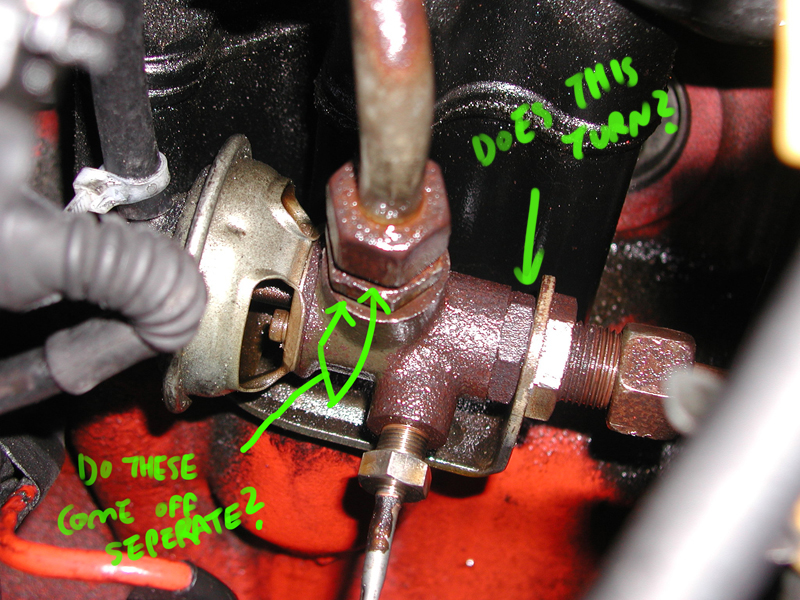|
Hi Greg,
The EZK-116 fault code 2-4-1 suggests a failure of the expected amount of exhaust gasses, as measured by the temp sensor.
The meaning of the OBD socket six EZK116k ignition fault code 2-4-1 is that the EGR system flow too low.
https://www.brickboard.com/FAQ/700-900/EngineOBDCodes.htm
So, when the EGR system, controlled by the Bosch EZK116k so equipped with EGR, activate the EGR vacuum pump (what you call the vacuum booster) to open it, the EGR system program measures the duration of temperature rise (if equipped with an exhaust gas temp sensor) across it.
EGR Vacuum Pump on my 1991 Volvo 240

EGR Piping Termination at Air Intake Port (Manifold) Downstream from EGR Valve

So, you may indeed have a faulty vacuum pump. Though that seems a rare events. (I've not heard or read of one failing. Though they may need to have the dirt and egine grime clean off them.
More so, the white and yellow vacuum lines may not be seated. The rubber sealing ends may have deteriorated or have themselves become unseated. Verify the seating of the EGR vacuum lines.
If you run regular mineral oil, or practice stop and go driving, without letting the engine to fully heat up ever few drives, so the oil is hot enough to boil out moisture and combustion byproducts, and the exhaust system to dry out, the EGR piping from the back of the exhaust manifold, to the EGR valve, and from the EGR valve to the air intake port (manifold) can become clogged with condensated combustion buy productions from exhaust gasses. This usually happens downstream of the EGR valve more so, yet the EGR piping can come clogged just upstream of the EGR valve and deposits grow backward through the EGR pipe back to the fitting at the back of the exhaust manifold.
EGR Temp Sensor Location

EGR Temp Sensor Location

EGR Valve on Volvo 740/ 940 B230 Turbo (not my image 0 temp sensor on EGR Valve Body.)

The pipe connection to the right of the EGR valve in this photo connects to the exhaust manifold rear. The emanating from the left side moving to the toop of the photo is the pipe that connects to the exhaust manifold.
So, you can verify vacuum line connection, check function of the EGR vacuum pump in that it works when 12 VDC is applied (dunno what is polarity, check:
http://www.volvowiringdiagrams.com/?dir=volvo/240%20Wiring%20Diagrams
... or your Bentley Volvo 240 Bible Service Manual for wiring and other detail.
And also check that the EGR piping is not clogged. However, the first large EGR pipe can come corroded over time. And if rusted on the exterior (rust usually begins at the exhaust manifold side), take care tio remove it or have a spare in the event any of the EGR piping self-destructs on disassembly.
The EGR Valve connects using collets that seal on the EGR pipe exterior and within the assembly hardware on compression. You may encounter 22 and 24 mm nuts at either end. I've had to clean a few EGR systems as that was the cause for their malfunction. You may be surprised the crusty mess that comes out.
The EGR system can fail in the opposite way in that the EGR Valve fails in the open position with hot exhaust gas passing into the air intake port (manifold). It can sort of screw things up and requires an immediate fix, if removing he EGR pipe from the rear of the exhaust manifold and plugging with a quality short bolt and washer to seal against the hot exhaust gasses. And disconnection the EGR pipe at the air intake port, and sealing the hole at the air intake port.
EGR reduces fuel economy by about 1 mile per gallon over 240s with Bosch LH-Jet 2.4 / EZK ignition. You may want to check the Minnesota state emissions controls as you may be able to remove the WEGR system, yet that may require at least a Bosch EZK 116 controller without EGR and corresponding LH-Jetronic 2.4 control module without EGR.
http://www.nuceng.ca/bill/volvo/database/ecu.htm
(Too bad Bill's list here does not show the EZK ignition module controllers that comes with the LH-Jetronic controllers by Bosch part number.)
You may need to rearrange the wire harness connections at each controller to match the inputs of both controller without EGR.
Heck, a new coolant sensor and cleaned up wire harness connections on the engine control, and all grounds, may do more to improve your fuel economy and reduce your emissions than what good the EGR does.
Questions?
Hope that helps you.
Sat-Your-Day Eve Midwest MacDuff, hangin' out down by the brickboard.com.
--
Jonathan Harshman Winters III: The Mightiest, Greatest, & Most Powerful North American Comedian & Comedic Actor in Perpetuity
|






